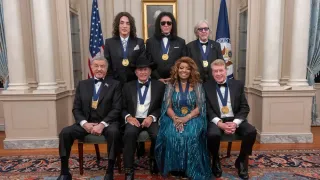November 1, 2020
Out and Proud? Not So Much for LGB Republicans, New Survey Maintains
READ TIME: 4 MIN.
In a new survey Williams Institute found LGB Republicans haven't the Pride vibe of their Democratic counterparts. It can even be said that a surprisingly high number of LGB Republicans wish they weren't gay at all.
"Compared with Democratic LGB people, more Republican LGB people said they would want to be completely heterosexual and that being LGB is a personal shortcoming. But similar proportions–more than a third–of LGB people of both party affiliations said they had tried to stop being attracted to same-sex partners at some point in their life," concludes the report.
The Williams Institute "used data collected in 'Generations,' a study that explored identity, stress, health outcomes, and health care and services utilization among three generations of LGB adults who came of age at different historical contexts, The study used a national probability sample of LGBT people recruited between 2016 and 2017. In this report we focus on non-transgender LGB individuals (including those identified with other sexual minority identities, like queer and pansexual) whose party affiliation was Republican or Democrat."
The results show "some similarities but also important differences between Republican and Democratic LGB people 5 in how they view their sexual identity and how they connect to the LGBT community," writes the researchers.
The Williams Institute used using five indicators that describe the relationship LGB people have with their identity and their connection with the LGBT community: Disclosure (Outness), Perceived Stigma, Centrality of LGBT Identity, Internalized Homophobia, and Community Connectedness.
In the Disclosure (Outness) category, the report concluded: "Republican and Democratic LGB people were similar in the degree that they disclosed their sexual identity. Most people of both party affiliations disclosed to family members, straight friends, coworkers, and health care providers that they were LGB."
The same was true of the Perceived Stigma category. "Also, Republican and Democratic LGB people perceived similar levels of rejection and discrimination in the communities where they lived. A majority of each group said that they believed that people thought less of an LGB person and that most people would not want to hire an openly LGB person to take care of their children. Still, a majority of people of both party affiliations thought that most employers would hire an openly LGB person who is qualified for the job."
The party affiliations show a divergence in the Centrality of LGBT Identity. "Republican and Democratic LGB people differed in how they felt about their sexual identity and relationship to the LGBT community. Compared with Democratic LGB people, fewer (but still a majority) of Republican LGB people said that being LGB is a very important aspect of their life."
But where LGB Democrats and Republicans show their starkest difference is with Internalized Homophobia. "Compared with Democratic LGB people, more Republican LGB people said they would want to be completely heterosexual and that being LGB is a personal shortcoming. But similar proportions–more than a third–of LGB people of both party affiliations said they had tried to stop being attracted to same-sex partners at some point in their life."
Asked if they would want to be "completely heterosexual," 41% of Republicans answered they would compared to 17% of Democrats. The parties were closer when asked if they wished they weren't LGB with Republicans edging the Democrats (23% to 19%). A small percentage acknowledged they had seeked help in to change (4% of Republicans; 3% of Democrats). But the numbers wildly diverge with the question if those asked see "LGB as a personal shortcoming" with 38% of Republicans seeing it as one and only 16% of Democrats. The only question where both parties were virtually tied (37% for Republicans; 36% for Democrats) is responders have attempted to stop being attracted to members of the same sex.
And in the final category – Community Connectiveness – there "were very marked differences in Republican and Democratic LGB people's sense of connectedness with the LGBT community. Republican LGB people were less likely than Democratic LGB people to feel that they are a part of the LGBT community, to agree that participating in the LGBT community is a positive thing, to feel a bond with the LGBT community, to be proud of the LGBT community, and to feel that problems faced by the LGBT community are their own problems."
Here the Democrats (72%) far outweighed the Republicans in terms of feeling part of the community with Democrats (76%) and Republicans (46%). Similar disparities came with other questions in this category. Democrats see participating in the LGBT community as a positive thing (85% to 60%); feel a bond with the LGBT community (70% to 45%); and the importance of being politically active within the LGBT community (72% to 36%).
In summary," the researchers write. "this shows a diversity of opinions among LGB people. Although a small minority, LGB people are affiliated as Republicans. Republican and Democratic LGB people similarly perceive stigma against LGB people in their communities. But they differ in terms of their connections with LGBT communities. Our data show that Republican LGB people have a weaker connection to the LGBT community than Democratic LGB people and half as many Republican as Democratic LGB people said that it was important for them to be politically active in the LGBT community."






